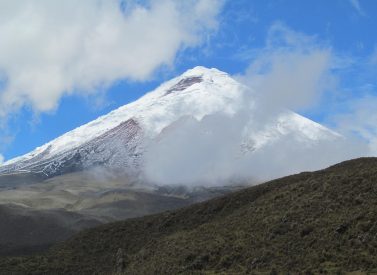Our Guide to the Top 5 Ecuador Volcano Hikes and Climbs
 by Tom Shearman on 21st June, 2022
by Tom Shearman on 21st June, 2022
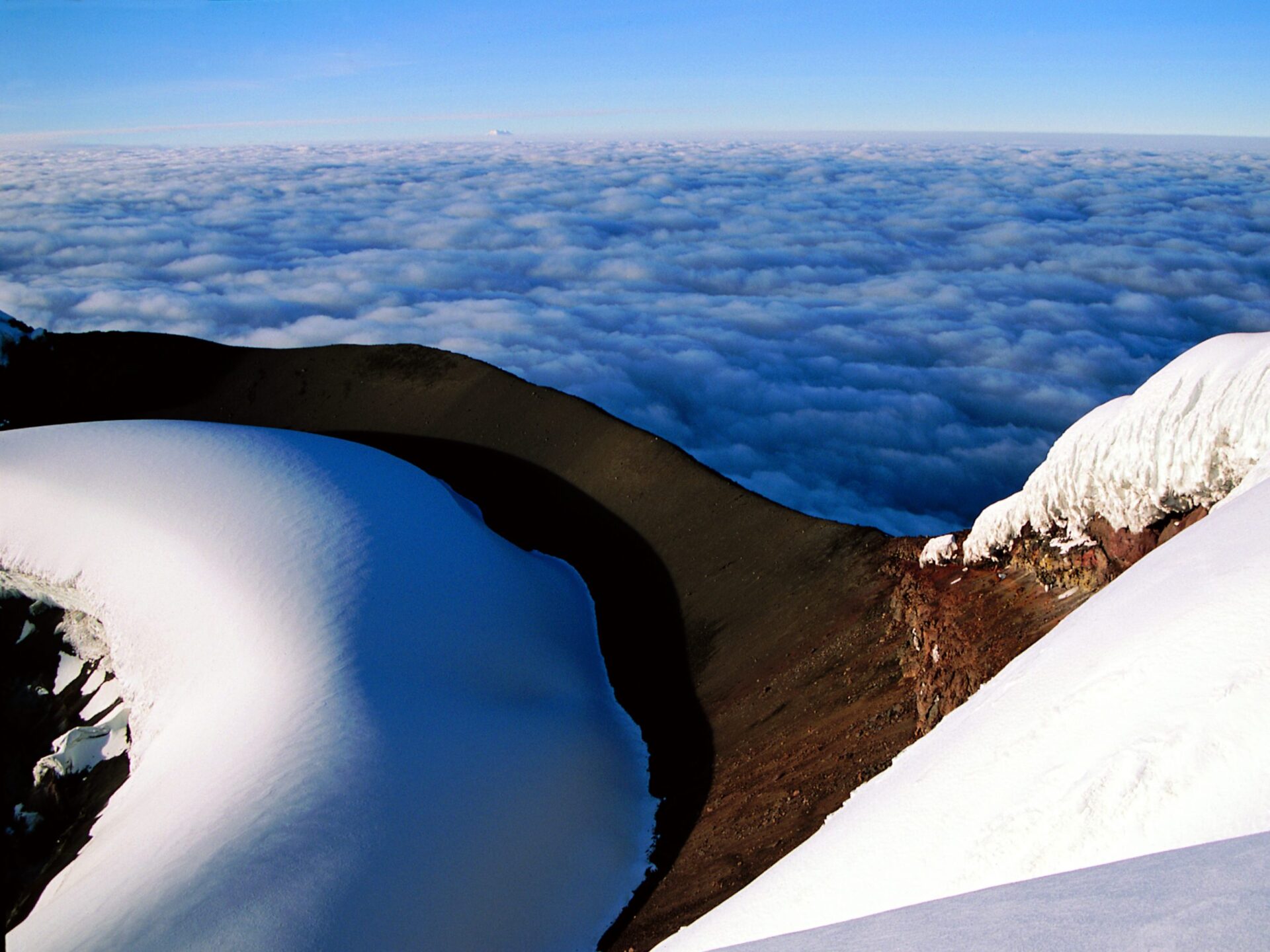
Yepo
Ecuador’s volcanoes offer some of the most exciting mountaineering routes in the Andes mountains.
There are walking acclimatisation peaks, technical summits, and everything in between in what is known as Ecuador’s Avenue of Volcanoes.
Some of Ecuador’s volcanoes require fully-supported expeditions; others are day trips from Quito or nearby. The variety is astounding, but the beauty remains constant throughout.
The only real issue is which to choose to explore and enjoy.
What Is the Avenue of the Volcanoes?
Ecuador is home to the Avenue of the Volcanoes, so-named by the German explorer Alexander von Humboldt in the early 1800s.
It’s easy to see how he conjured the name by looking at a map. Eight principal towering snow-capped volcanoes straddle a fertile valley from the south of Ecuador up to the north. Many of Ecuador’s volcanoes are still active.
Travelling between Ecuador’s volcanoes is a true pleasure, with its dense forests, indigenous villages, and thriving farmer and artisan markets. Colonial estates pock the land, too, the grandeur of the conquistadores’ accommodation surviving today as tourist estancias and hotels.
The Avenue of the Volcanoes isn’t just snow-capped cones and dizzying slopes. Beautiful, turquoise lakes and occasional thermal hot springs often provide lovely views of Ecuador’s enormous Andean mountains.
What Mountains Form the Avenue of the Volcanoes?
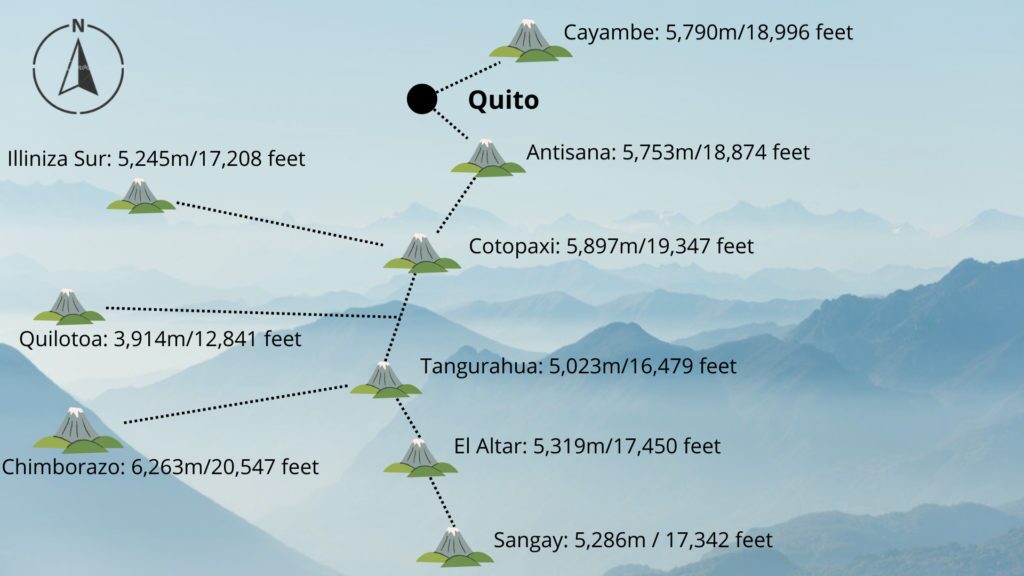
Eight principal volcanoes form the spine of the Avenue of the Volcanoes.
The most prominent peak in Ecuador is Chimborazo, in the country’s south. Cotopaxi and its surrounding national park is the most favoured mountain to visit, thanks to its beautiful, snow-capped and perfect cone shape.
From north to south, here are the main mountains in the Avenue of the Volcanoes:
- Cayambe: 5,790m/18,996 feet
- Antisana: 5,753m/18,874 feet
- Illiniza Sur: 5,245m/17,208 feet
- Cotopaxi: 5,897m/19,347 feet
- Quilotoa: 3,914m/12,841 feet
- Tangurahua: 5,023m/16,479 feet
- Chimborazo: 6,263m/20,547 feet
- El Altar: 5,319m/17,450 feet
- Sangay: 5,286m/17,342 feet
When Is the Best Time to Visit Ecuador Volcanoes?
The best time to visit the Avenue of the Volcanoes depends on how high you wish to climb. Ecuador, in general, is a year-round destination, and even in the rainy season, people staying at lower levels can enjoy sunny mornings with only chances of afternoon rain.
Overall, the best period to visit Quito and trek and climb Ecuador’s volcanoes is from June to Sept and Dec to early February, also Ecuador’s high season. During the Oct to May wet season, most rainfall is in the afternoons.
The Best Ecuador Volcanoes for Hiking and Climbing
Let’s look at some of the acclimatisation peaks and the more technical summits, with something to suit everyone’s mountaineering tastes.
Cotopaxi: Acclimatisation, Glacier, or Summit
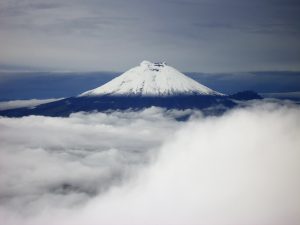
Cotopaxi is Ecuador’s most famous mountain. This snow-capped volcano’s perfectly conical peak makes it one of the most photogenic in the world.
The most accessible walk involving one of Ecuador’s volcanoes is the 90-minute flat hike around Laguna Limpiopungo. This lake is situated in Cotopaxi National Park and, on clear days, affords stunning views of the nearby Cotopaxi summit.
Wetlands provide homes for birds, including hummingbirds, and people often see some of the National Park’s wild horses grazing nearby. Keep your eyes peeled for Andean Lapwings and Sierra Finches, too.
Expedition to Cotopaxi’s Glacier
Adventure travellers wanting a taste of high-altitude trekking and glaciers can achieve both at Cotopaxi. Staying overnight in Cotopaxi National Park means a one-hour drive to the Cotopaxi Mountain Refuge (4,800m/15,748 ft approx.) to start the walk the next day.
Take it slowly for the next two hours as you gain altitude to reach the edge of Cotopaxi’s glacier, a stunning sight. The northern side of Cotopaxi has a breathtaking panorama, with Quito, Pasochoa mountain, Pita Canyon, and the magnificent Limpiopungo valley on display.
Trekkers may wish to get a full view of Cotopaxi on our lodge-to-lodge trek.
Climbing Cotopaxi
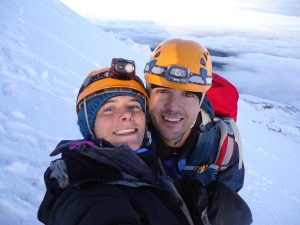
Cotopaxi is very high at 5,897m/19,347 feet. Newcomers can try the climb, learning required skills in a glacier school with our qualified, expert mountain guides.
We recommend good acclimatisation first, ideally by climbing Illinizas North (5,100m/16,732ft), having got used to high altitude beforehand.
Day 1: Climb Pichincha, 4,794m/15,728ft, return Quito
Day 2: Refugio Ilinizas, 4,700m/15,420ft, mountain refuge
Day 3: Climb Ilinizas North, 5,100m/16,732ft, travel to Hacienda La Estacion
Climbing Cotopaxi will send you past glacier walls, snow bridges, and crevasses en route to the beautiful summit dome. It’s a 6-7 hours climb from the Cotopaxi Mountain Refuge to the summit.
Climbing Cayambe or Glacier School
Cayambe is another volcano that offers newcomers to climbing the chance to gain glacier skills and then put them into practice immediately.
Acclimatisation is essential before any glacier school or summit attempt. Like almost all high Andean peak attempts, Cayambe involves a midnight start, climbing in the dark with head torches.
There are crevasses and spectacular seracs (ice pinnacles) as we make our way up to 40-degree slopes and occasionally steeper ones. The last hour is on a 60-degree slope to the summit.
Climbing Chimborazo
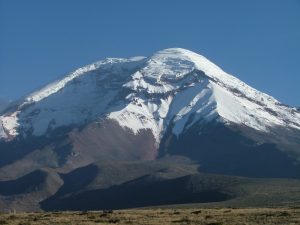
Chimborazo’s sheer height (6,263m / 20,547 feet) means it’s often best tackled on a fully-supported expedition and after climbing Cayambe of Cotopaxi.
Like many of Ecuador’s volcanoes, it may only take a day or two to climb Chimborazo. However, acclimatisation and excellent fitness are a must.
Our summit day starts at the refuge (4,800m/15,748ft). A midnight departure leaves us with a lot of height to climb, around 8-9 heading up and a further 4-5 hours on the descent.
Ice climbing skills, roping up, and crossing crevasses make this a challenging peak.
Climbing Antisana Volcano
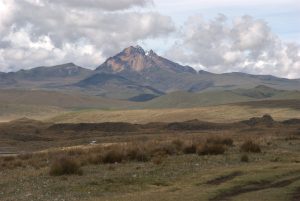
Antisana is Ecuador’s fourth highest volcano, one of its least climbed, and one of its cloudiest. If that makes it sound a little tricky, that’s because it is a tough one to climb.
Active glaciers make Antisana’s route planning changeable. There are many beautiful seracs and lava flows to see, and Antisana is still active, last erupting in 1802.
It takes two days to climb Antisana from the start point, and we recommend hiring professional guides for this route. There is no refuge, and a base camp is required. Plus, climbers need advanced ice-climbing skills to be safe on Antisana.
Climbing El Altar Volcano
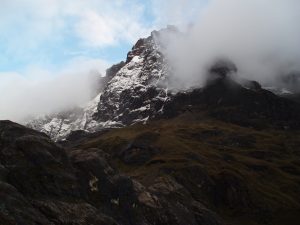
El Altar is one of the most spectacular of Ecuador’s volcanoes and its fifth highest. Its Spanish name came from its resemblance to a cathedral. It truly is the celestial climb in the country — the hardest and most technical of all the Ecuador volcanoes.
Nine summits spread over a rim shaped like the curve of a capital D. Anyone attempting any of the nine peaks must be very experienced in rock climbing and alpine mountaineering.
El Altar is extinct and requires a long climbing day and various climbing skills. Steep snow and ice and glaciers face the climber and narrow ice gullies. The final section to the Obispo summit needs technical rock skills and a rappel and climbing descent.
Climbing El Altar takes two days from the start if climbers are thoroughly acclimatised.
Hiking at Quilotoa
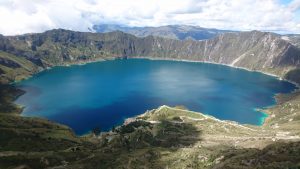
Quilotoa is a highlight for anyone visiting Ecuador. Don’t forget, it’s high at 3,914m / 12,841 feet but also the lowest height of any volcano on this list.
People can visit the viewpoint or walk down to the beautiful emerald green waters. Keep an eye on the lake at all times; Quilotoa’s crater lake shimmers as the weather changes.
The walk down (around 400m/1,312ft descent) takes 5-7 hours. Suitable footwear is essential; tired hikers can hire mules or horses to bring them back up from the lake edge. Kathy’s blog provides a lot more advice.
Hiking and Climbing Ecuador Volcanoes
Ecuador’s volcanoes make equally fantastic photographs as they do adventure playgrounds. Remember, be you looking for a life-changing expedition or some acclimatisation before higher peaks and summits, the Avenue of the Volcanoes has something for you.
Contact us for more about mountaineering and visiting Ecuador.
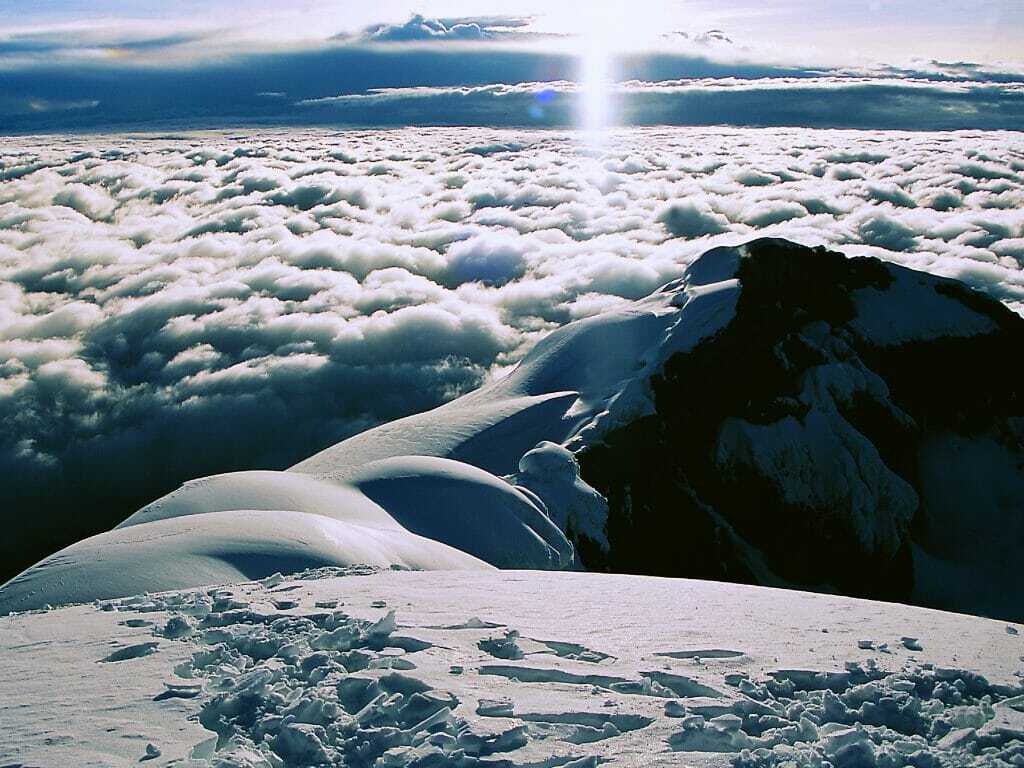


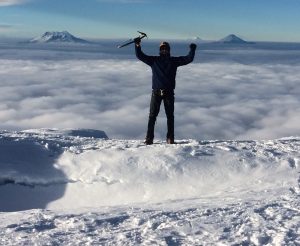
 a Tailor Made Tour
a Tailor Made Tour 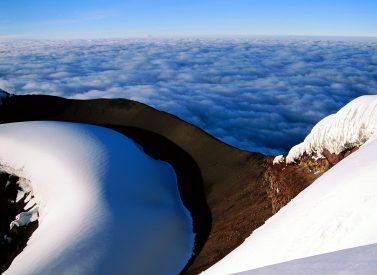
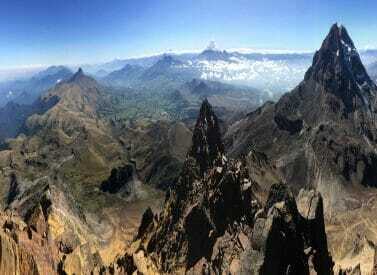
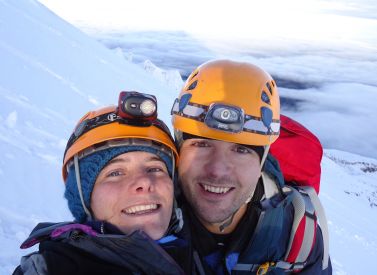

 a Group Tour
a Group Tour 